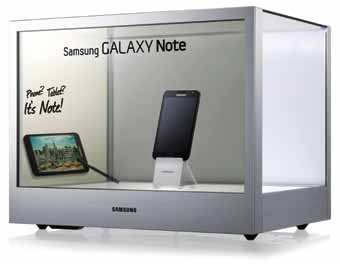According to the company’s announcement at FPD International 2012, “In Pixel Eyes technology, the touch-panel is built in, rather than being attached from outside. The structure becomes simple, so it’s easy to make the display thin. Such a thin display is very sensitive, so we’ve utilised that to enable writing with a pen. Currently, finger operation is the norm, but we would like to provide a pen-drawing solution next.”
A screen that can bulge into buttons
We like to swipe and pinch our screens, but there are still times when we wish for a traditional keyboard experience—say, when typing a long document.
Californian company Tactus Technology together with Touch Revolution seems to have an answer. Their new touch panel looks like the normal touch screen displays on existing handheld gadgets but it uses a tactile layer that sits atop the touch screen. This tactile layer is composed of fluid-filled micro-channels, which can alter fluid pressure and redirect the liquid to create blister-like buttons. Similarly, it can also make the buttons disappear in a jiffy.
This morphing technology can be used to give users a keyboard on-demand experience, by transforming a touch screen’s flat surface into real physical buttons. While in the initial stages the company has preprogrammed the size and shape of the buttons, in the future it will be possible for the user to configure these too. The tactile layer consumes very little power while forming the buttons, but there is no power consumption once the buttons are active.
This technology is expected to be used in products starting 2013.
Touch magic in large, retail displays
It is not just mobile phones and such personal devices that are into the touch fad. Retail displays are also getting a huge touch makeover. Industry experts claim that users are so used to touch-enabled displays in their personal devices that they expect the same interactivity to be extended to larger-format screens as well. What sets this segment apart is the need for robustness—as the displays will be frequently used by several untrained users.
Spice king McCormick recently opened its World of Flavors—a 353sq.m complex at the Baltimore Inner Harbour, in USA, where it has deployed 107cm (42-inch), touch-enabled HP digital signage displays and HP TouchSmart All-in-One PCs. Apart from several digital engagements, including a guess-the-spice game, it has setup an 8.5m (28-foot) wall dedicated to broadcasting McCormick’s past and history of spices and flavours in an immersive experience.

J2 Retail Systems, makers of special digital displays for the retail world, also has some interesting products such as the TFR and Pro-Cap. Their True Flat Resistive (TFR) screen has a bezel-free design that makes it a totally flat, sealed screen that is both practical and stylish. The TFR screen’s IP rating denotes that it can be used outdoors.
For exceptional durability, J2 is also equipping some of its models with Projective Capacitive Touch (Pro-Cap) screens, which apparently come with an almost unlimited touch life. These scratch-resistant glass screens are said to be durable, while also delivering stable performance with exceptional screen clarity and brightness. Pro-Cap screens also allow finger touch inputs such as gesturing, and are unaffected by moisture, temperature or harsh cleaning products. J2 offers touch screens in 5-wire resistive, surface acoustic wave (SAW) and infrared types.
Samsung has created much more excitement with three new technologies unveiled at the GITEX Technology Week held in October this year at the Dubai World Trade Centre: a transparent display (NL22B), a 190cm (75-inch) LED LFD (ME75B) and a 3D video wall.
The NL22B transparent display can be used to create an immersive shopping experience. It may also be used in other fields such as healthcare and education. The 56cm (22-inch) transparent display is a cube-shaped device that contains a transparent front panel with a computer built into the chassis. It allows images and animations to interact with the products showcased inside the cube. So it can be used in a store to allow users to interactively find out more about products, try out various combinations, etc, before making a purchase.
The ME75B is a cutting-edge, huge light-emitting diode (LED) display that is energy-efficient, smart and network-enabled. It can adjust brightness by itself, and has a built-in media player too, which makes it a standalone device. It can be used with a touch overlay and can be implemented at stores or restaurants to provide customers with an interactive guide.
The 3D video wall is a slim, edgelit, high-definition LED panel—another product that will be loved by retailers!






